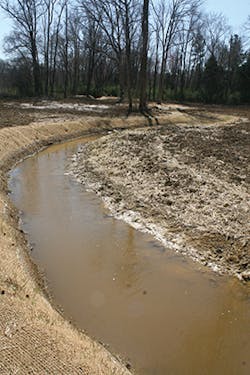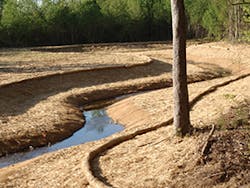Project Profile: Back to the Future
The Clean Water Act of 1972 is often viewed as one of this country’s seminal pieces of modern environmental legislation-and rightly so. But while its impact conjures up images of finally cleaning up the almost-dead Great Lakes, or stopping Ohio’s Cuyahoga River from catching fire (as it had on numerous occasions in the past), the act also had many other far-reaching statutes, provisions that, to this day, are still making their impact felt. One of those includes the mitigation of wetlands adversely affected by development and the offset projects that are driven by such development. At a farm site in Monroe, NC, environmental remediation specialist Wright Contracting LLC-fulfilling just such an offset requirement-took more than 5,000 feet of what had become an unsightly drainage channel and, combining its proven expertise with some innovative, GNSS-based techniques, returned it to its former pristine condition.
Making Things Wright
Established in 2008 in Lawndale, NC, Wright Contracting quickly established itself as one of the region’s premier specialists in environmental restoration, with a focus on remediation of streams and wetlands. Headed up by founder Joseph Wright, the company also tackles storm water remediation projects and other urban environment projects.
“This is a field I have loved since majoring in biological and agricultural engineering at North Carolina State,” he says. “One component of that program was devoted to stream restoration, and I’ve been hooked ever since. As a company, we started out small but quickly found a niche for this type of work throughout the region. Today we are about a dozen strong, and a good part of the reason for the growth we’ve enjoyed has been the input and expertise of Stephen James, who came onboard with us in 2012. His expertise-and his push to add GPS to the operation-moved us from an average company to a major player in this market.”
James, who came to Wright Contracting with more than a decade of GPS experience, has also been involved in stream restoration for about six years. Based on an ongoing friendship with Wright and a desire to see his friend succeed, he recommended the move to a GPS-based work environment even before joining the firm himself.
“I first talked Joe into buying a rover two years ago, knowing that it would help him out and save a lot of time and effort. They purchased a Sokkia GRX-1 in 2010, used it on one job, and immediately fell in love with it. This year, working through Benchmark Supply, we added Topcon’s X-63 machine control system for our Volvo excavator and a HiPer II base/rover. By nature of its ability to increase productivity and minimize the risk of error, GPS has become a major part of our operation.”
Streaming GPS
That GPS component recently paid big dividends at the Monroe stream restoration project. There, Wright and his team took a water feature that had been modified and neglected for decades and brought it back to its former state.
“Prior to us coming in, there was no vegetation-it was just a straight ditch through the middle of this farmer’s field,” says Wright. “Part of what we strive to do is restore the floodplain. We then add sinuosity back to the stream so that, instead of a straight ditch, there is some curve and flow to it as it moves along-in this case, through a small valley. We also add grade control structures, pools and riffles, as well as plant vegetation, both to keep the newly routed stream in place and to maintain a specific elevation.”
That elevation, he adds, is necessary to ensure that the water is always able to exit onto the flood plain, yet stay in that path and take a natural course. Almost every facet of what’s been done at Monroe-including layout, placement of structures, excavation, creation of slopes, and more-has been done using GPS.
“The only stakes pounded on this entire site were those used to secure the coir matting holding vegetation in place,” says Wright. “Drawing upon GPS technology has made all the difference in the world. Not only would the number of stakes needed for a job of this size be insane, but training workers to read them, then having to double check everything, would really slow us down. GPS eliminates all that and allows us to build it right the first time, keeping production high. There are also fewer questions or conflicts, because we are accurately building the engineer’s design. I like to think of ourselves as artists using our bucket as a brush to recreate the engineer’s CAD screen.”
Cash Cab
Wright’s affinity for the new technology is shared by Bruce Hall, the firm’s excavator operator. He says there were many areas of the Monroe project in which the difference between having machine control on his Volvo 220D and the traditional way of doing things was stark.
“There’s really no comparison between the two,” he says. “In the past, before making a cut, we’d have to pull tapes, lay it out, paint our marks or pink flag them, and so on. Now I can get the same results from right in my cab. All the slopes for the stream are built into the model, so the indicator lets me know if we are too low or too high. In addition, because so much of our work is under water, we sometimes can’t actually see what we are trying to grade. Before, that would have meant having a man out there with a grade rod. Instead, because the system’s sensors know where the bucket is at all times, I just look on the screen and everything I need is right there. I can even flip back and forth to different views as we move down the job.”
Wright adds that, while experience is key in stream restoration, the crew can now couple that know-how with what is essentially a constant look at the engineering plans. In being able to do so, he says, production skyrockets.
“Construction is all about production and making sure you have a good quality product,” he says. With machine control, to paraphrase, we are killing two birds with one system. The operator is able to look at the job, build it accurately, and keep production up; he no longer has to stop to look at the plans and measure. Depending on the conditions, all those benefits can translate to anywhere from a 25% to 50% increase in production. That’s a very nice savings.”
The Whole Package
In addition to the benefits mentioned above, Wright says being able to increase productivity in a stream restoration project has a definite trickle-down effect on the entire operation. Rainfall, for example, doesn’t directly affect them-they can generally work through it-but the increased flows it generates will.
“If it rains, we have flow issues, with huge volumes of upstream water coming down onto us,” he explains. “So anytime we can speed up production and keep ahead of a situation like that is a plus. It also allows us to get vegetation in and established quicker, shortening the time the project is exposed to the elements. In this business, vegetation is your insurance policy; without it, no matter how much matting you have down, flow will damage your work.”
At Monroe, Wright and company planted a fairly broad range of native plant material, right down to the plant and grass seeds. High-stress areas such as a bend in the stream, which are particularly prone to damage, are quickly seeded, straw is added, then it is all covered with a coir blanket with 1-inch holes. “Again, getting that done as quickly as possible minimizes the risk of damage. GPS, because of its inherent advantages over surveying and staking, has done that for us.”
Credit Where It’s Due
A huge percentage of Wright Contracting’s work, including the stream project in Monroe, comes as a result of a specific offset credit program in place in North Carolina. Called the North Carolina Ecosystem Enhancement Program (NC EEP), the service coordinates wetland and stream mitigation efforts for both public and private land developers. In addition, they contract with construction companies and consultants to create mitigation sites and buy credits from mitigation providers. One such provider, Raleigh-based Environmental Banc & Exchange (EBX), is heading up the mitigation effort at the Monroe site.
“Doing mitigation projects to generate credits has been ongoing here in North Carolina since about the early ’90s,” according to Martin Hovis, EBX’s project manager. “The concept is fairly simple: if a contractor or an agency like NCDOT wants to build a road, they have to get it permitted. However, if that road is going to impact an existing waterway or body of water, they have to get a permit from the Army Corps of Engineers to build it. Before they can get permitted, however, they have to replace what’s being impacted with a new waterway of equal size elsewhere, usually within the same watershed. By working with companies like Wright Contracting, we provide the means to make that happen.”
According to Wright, an overwhelming majority of the company’s work is in some way connected to the offset program in place in North Carolina. “This is an effective, well-run program that helps maintain an environmental balance throughout the state,” he says. “We’ve done well because of it, and I’d like to think the reverse is true as well.”
Additional Opportunities
Having more than established his company’s place within the region, Joe Wright has started moving toward establishing Wright Contracting as a national presence. At a project in the Houston area, the firm is making ready to begin a project calling for the mitigation of more than 20 miles of stream.
“This is going to be an excellent opportunity for us to take the business to the next level,” he says. “Because of the sheer size of that job, we are anticipating working with Benchmark Supply to add two more X-63 systems for our excavators. I’ve found that GPS can be habit-forming-once you start with it and realize the benefits it can provide, you just want more.”
As the company moves forward, one can’t help but feel it is destined for good things. Perhaps a reflection of his push for a positive group dynamic between the entire crew, Wright says his company is actually more like a small family and he is very optimistic for the future.
“I’m a southern Baptist boy and am not afraid to say that we are very blessed to be where we are at today,” he says. “I attribute that to the good Lord, good people, and good tools to make it all happen.”




